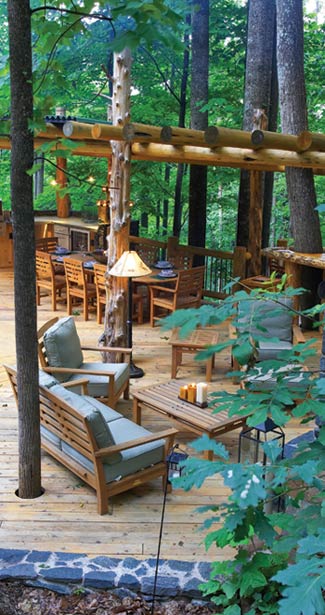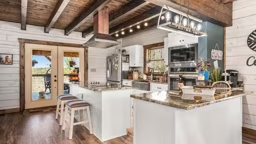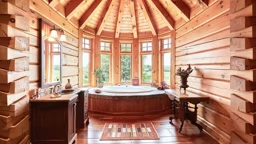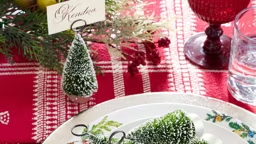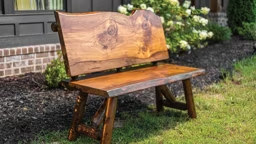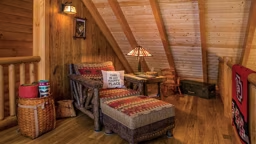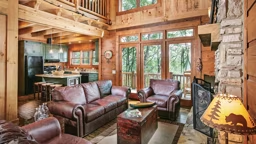To whip up a delicious outdoor kitchen for your log home, follow these tips and your guests will be giving their compliments to the chef.
Picture it:You're hosting a barbecue for friends and family on the deck of your log home, enjoying a beautiful late-summer evening. The only problem? You've missed half the party, dashing to and from the kitchen for extra plates, beverage refills and side dishes.
To avoid this entertaining pitfall, an outdoor kitchen can be a smart backyard upgrade. You'll be able to cook a complete meal while chatting with your guests, not stuck in the house waiting for the corn on the cob to boil.
The best part? An outdoor kitchen adds value and space to your abode. And though you could go hog wild and design an outdoor kitchen with the latest gadgets and gizmos, a few simple essentials are all you need to transform your deck or patio from ho-hum to yum.
"Outdoor living spaces extend the footprint of your home," says Mark McCoy, a certified kitchen designer with the Jay Rambo Company in Tulsa, Oklahoma. "You'll have a very inviting space for several months of the year."
An open-air kitchen is ideal for any log home, according to Deborah Krasner, author of The New Outdoor Kitchen. "It's a natural choice because log home owners love spending time outside," she says. "The view from your table will be of your beautiful log home."
Design Recipe:
The first step to a sizzling outdoor kitchen is to decide where to put it. Some homeowners plan kitchens on porches, patios or decks to be near electricity, gas and water sources. Others set up shop under gazebos, near pool houses or in gardens and then hire electricians to install wiring. Easy access to your indoor kitchen will be helpful if you'll be using essentials like plates, flatware, and pots and pans in both areas. And make sure you orient your outdoor kitchen to capture the magnificent views from your property.
So what's the basic layout for any dinner party-worthy outdoor kitchen? Follow the lead of your primary kitchen: You'll want a cooking area, a dining space and a "room" dedicated to socializing, such as a bar or just a couple of lounge chairs. When designing your cooking and prep areas, try placing your work spaces so they're in a logical order. Start with the sink, place a prep station next to it, then finish with the cooking zone to make dinner preparations easier. Also, be sure there's separation between the grilling area and where you'll be mixing cocktails: You don't want to charbroil guests who are refreshing their drinks.
A roof overhead isn't necessary, but it does do wonders to make the area feel like it's a distinct room. It also can prolong the time you're able to spend outside if it shields you from the elements. To soften the lines of the roof and supporting posts, train climbing plants, such as trumpet vine or wisteria, to grow up the posts or plant evergreen shrubbery to create living walls that will enclose the space and add privacy.
Ample lighting is essential for post-sunset soirees. "You'll want task lighting in the prep area and by the grill," says Mark. Deborah suggests choosing hooded fixtures that shine light downward; they'll brighten your work zone but keep the night sky dark so you can stargaze. To illuminate your seating area, use landscape lighting that shines on foliage, Mark says. Or, if you have an overhead structure, try a ceiling-fan fixture for both air circulation and light.
The Right Ingredients:
A grill is a given, but consider the vast array of BBQ options available to backyard chefs. Do you prefer your food cooked via natural gas, propane or charcoal? You can plumb a natural gas line in a permanent structure, says Mark, or use more than one grill to cook for a crowd. Many grills also come equipped with side burners, so you can boil rice or heat up sauces while flame-broiling entrees, says Deborah. Some adventurous chefs incorporate masonry ovens, smokers and brick pizza ovens for even more versatility.
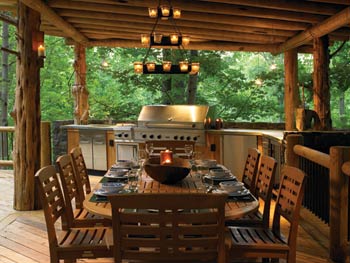 Bring indoor convenience to your yard with a sink and compact refrigerator. You can install a plumbed sink into a countertop or buy a portable version that attaches to a garden hose, a less-expensive alternative.
Bring indoor convenience to your yard with a sink and compact refrigerator. You can install a plumbed sink into a countertop or buy a portable version that attaches to a garden hose, a less-expensive alternative.
To house all of your grilling, dining and entertaining essentials, look for specially designed cabinets made of heavy-duty plastic with attractive stainless steel, cedar or teak shells that will hold up to Mother Nature. Weatherproof countertops in brushed granite, stone, stained concrete and flagstone styles have a rugged, rustic look that complement log homes, says Mark.
A smart built-in to consider? A trash receptacle in a pull-out cabinet or a garbage chute in a countertop that will keep scavenging critters away from your scraps. Don't settle for basic picnic tables and benches. "Lawn furniture has gotten very sophisticated," says Mark. "In fact, it looks like it should be inside your home, not outside."
Tables and chairs come in a wide range of styles: modern, traditional, even rustic, according to Deborah. "And the seats have more comfortable proportions and thicker cushions," she says. Look for fabrics that will stand up to the wear and tear of rain, snow and sunlight. But whatever you choose for your outdoor kitchen, remember that the essentials are the same for a great meal, indoors or out: good food and good friends.




